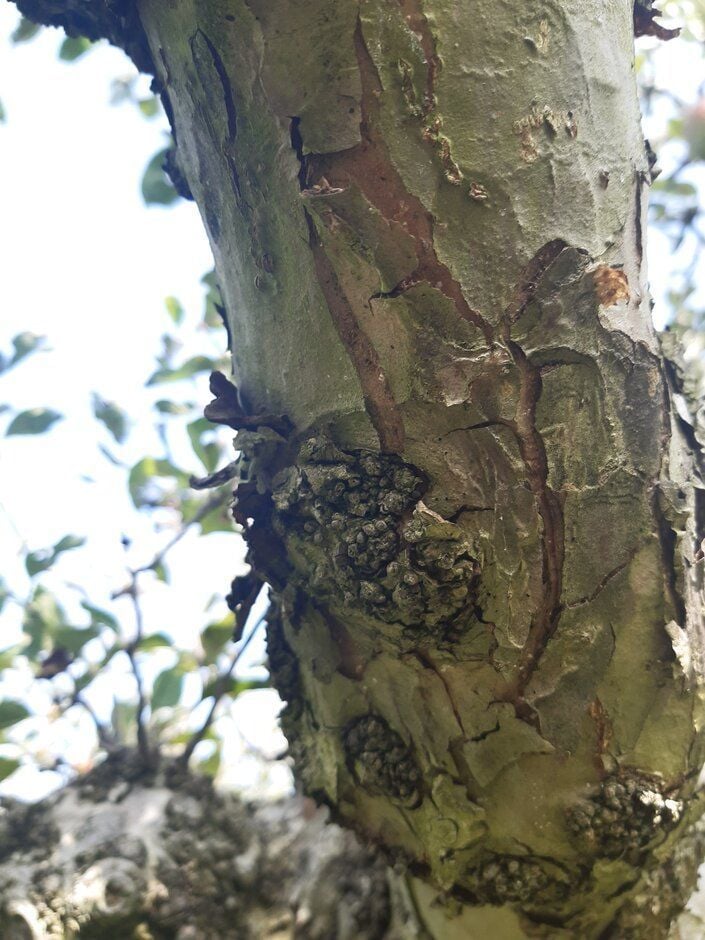Burr knots on apple trees
This unsightly disorder results in the formation of root-producing, tumour-like outgrowths on the trunk or branches.

Quick facts
Plants affected Apple trees, although quince and some other tree species can sometimes develop them
Main symptoms Tumour-like, ‘knobbly’ outgrowths on trunk or branches
Caused by Environmental conditions, linked to a genetic predisposition
Timing Symptoms visible all year; the burr knots enlarge when the tree is in active growth
What are burr knots?
Burr knots, also sometimes called burrs or burls, are root-producing structures that develop on the aerial parts of some apple trees. They are often triggered by environmental conditions, but certain rootstocks (e.g. the dwarfing rootstocks M9 and M26) and cultivars (e.g. Gala) are also genetically predisposed to their development.
Burr knots can be structurally damaging, and may also allow certain invertebrates (e.g. woolly aphid) or pathogens (e.g. apple canker) to colonise the tree.
Symptoms
- A small bulge or area of swollen bark may be all that is visible in the early stages
- As the burr knot enlarges it develops into a rounded, oval, or occasionally more irregular, tumour-like outgrowth
- The affected area often has a ‘knobbly’ appearance due to the presence of stubby adventitious roots
- Large burr knots can result in stunted growth, can structurally weaken the trunk or branch, and may lead to breakage
Control
Non-chemical control
Try to avoid creating the environmental conditions (particularly shade and high humidity) conducive to burr knot formation, particularly with rootstocks and cultivars known to be susceptible to the condition:
- Avoid weed growth and other thick vegetation beneath the tree, thereby allowing good air circulation and rapid drying of the trunk after rain
- Avoid the use of tree guards (particularly opaque types) unless absolutely necessary, as these can lead to high humidity around the trunk
Cutting out of burr knots could be attempted, particularly if the affected area is small, but the damage incurred when this is done means that colonisation by apple canker or other pathogens is still a possibility.
If a large burr knot reduces or even stops the growth of a branch it may be necessary to prune to produce a replacement branch.
Chemical control
There are no chemicals available to gardeners for the prevention or eradication of burr knots.
Biology
Burr knots develop when adventitious roots start to form on the aerial parts of the tree. At first only a single root initial may form, but over time more and more root initials develop in the affected area and the burr knot increases in size. It may take a year or two before the adventitious roots rupture the bark. The roots do not usually lengthen to any great extent, remaining stubby and giving a ‘knobbly’ appearance to the affected area. Older burr knots become hard and may develop an irregular bark covering.
Triggering factors for burr knot development are shade, high humidity and warmth. Some apple rootstocks and cultivars are genetically more susceptible to their development. In the case of rootstocks, clones that root readily (and are therefore easier to propagate from cuttings) are often chosen for this purpose, but this ease of root production then also sometimes leads to a tendency to produce adventitious roots and burr knots.
Large burr knots, or the merging of several knots, can lead to structural weakness or a reduction in growth. The damage caused by the rupturing of the bark as the roots emerge can lead to colonisation by invertebrates or pathogens, such as woolly aphid and apple canker (although not all of the cultivars prone to burr knot production are susceptible to apple canker).
There are some older apple cultivars that can be propagated by rooting pieces of branch with burr knots – these are often known as pitchers. This was once common practice in south-west England (particularly Cornwall) and south Wales. Cultivars that produce a lot of burr knots include ‘Ben’s Red’, ‘Burr Knot’, ‘Cornish Aromatic’, ‘Lord Burghley’, ‘Small’s Admirable’(syn ‘Captain Broad’), and ‘Winter Banana’. There is a tree in the orchard at Wisley of ‘Small’s Admirable’ (syn ‘Captain Broad’) that was propagated from a burr knot.
Burr knots can be an advantage to a tree growing in the wild, allowing it to layer and produce new trees, particularly if it grows on a hillside.
Get involved
The Royal Horticultural Society is the UK’s leading gardening charity. We aim to enrich everyone’s life through plants, and make the UK a greener and more beautiful place.